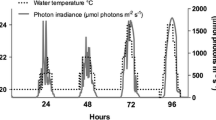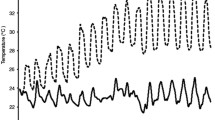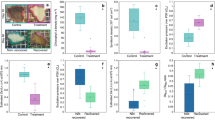Abstract
This study examined the capacity for photoprotection and repair of photo-inactivated photosystem II in the same Symbiodinium clade associated with two coexisting coral species during high-light stress in order to test for the modulation of the symbiont’s photobiological response by the coral host. After 4 days exposure to in situ irradiance, symbionts of the bleaching-sensitive Pocillopora damicornis showed rapid synthesis of photoprotective pigments (by 44 %) and strongly enhanced rates of xanthophyll cycling (by 446 %) while being insufficient to prevent photoinhibition (sustained loss in F v/F m at night) and loss of symbionts after 4 days. By contrast, Pavona decussata showed no significant changes in F v/F m, symbiont density or xanthophyll cycling. Given the association with the same Symbiodinium clade in both coral species, our findings suggest that symbionts in the two species examined may experience different in hospite light conditions as a result of different biometric properties of the coral host.




Similar content being viewed by others
References
Ambarsari I, Brown B, Barlow R, Britton G, Cummings D (1997) Fluctuations in algal chlorophyll and carotenoid pigments during solar bleaching in the coral Goniastrea aspera at Phuket, Thailand. Mar Ecol Prog Ser 159:303–307. doi:10.3354/meps159303
Asada K (1999) The water–water cycle in chloroplasts: scavenging of active oxygens and dissipation of excess photons. Annu Rev Plant Physiol Plant Mol Biol 50:601–639. doi:10.1146/annurev.arplant.50.1.601
Bachmann K, Ebbert V, Adams W III, Verhoeven A, Logan B, Demmig-Adams B (2004) Effects of lincomycin on PSII efficiency, non-photochemical quenching, D1 protein and xanthophyll cycle during photoinhibition and recovery. Funct Plant Biol 31:803–813. doi:10.1071/FP04022
Baird A, Bhagooli R, Ralph P, Takahashi S (2009) Coral bleaching: the role of the host. Trends Ecol Evol 24:16–20. doi:10.1016/j.tree.2008.09.005
Barbrook AC, Visram S, Douglas AE, Howe CJ (2006) Molecular diversity of dinoflagellate symbionts of Cnidaria: the psbA minicircle of Symbiodinium. Protist 157:159–171. doi:10.1016/j.protis.2005.12.002
Berkelmans R, van Oppen M (2006) The role of zooxanthellae in the thermal tolerance of corals: a ‘nugget of hope’ for coral reefs in an era of climate change. Proc R Soc Lond B Biol Sci 273:2305–2312. doi:10.1098/rspb.2006.3567
Bhagooli R, Hidaka M (2003) Comparison of stress susceptibility of in hospite and isolated zooxanthellae among five coral species. J Exp Mar Biol Ecol 291:181–197
Bhagooli R, Hidaka M (2004) Photoinhibition, bleaching susceptibility and mortality in two scleractinian corals, Platygyra ryukyuensis and Stylophora pistillata, in response to thermal and light stresses. Comp Biochem Physiol A: Mol Integr Physiol 137:547–555. doi:10.1016/j.cbpb.2003.11.008
Brown B, Ambarsari I, Warner M, Fitt W, Dunne R, Gibb S, Cummings D (1999) Diurnal changes in photochemical efficiency and xanthophyll concentrations in shallow water reef corals: evidence for photoinhibition and photoprotection. Coral Reefs 18:99–105. doi:10.1007/s003380050163
Brown B, Downs C, Dunne R, Gibb S (2002) Preliminary evidence for tissue retraction as a factor in photoprotection of corals incapable of xanthophyll cycling. J Exp Mar Biol Ecol 277:129–144. doi:10.1016/S0022-0981(02)00305-2
Campbell DA, Tyystjärvi E (2012) Parameterization of photosystem II photoinactivation and repair. Biochim Biophys Acta 1817:258–265. doi:10.1016/j.bbabio.2011.04.010
Coffroth M, Santos S (2005) Genetic diversity of symbiotic dinoflagellates in the genus Symbiodinium. Protist 156:19–34. doi:10.1016/j.protis.2005.02.004
Demmig-Adams B, Adams WW (2006) Photoprotection in an ecological context: the remarkable complexity of thermal energy dissipation. New Phytol 172:11–21. doi:10.1111/j.1469-8137.2006.01835.x
Dimond JL, Holzman BJ, Bingham BL (2012) Thicker host tissues moderate light stress in a cnidarian endosymbiont. J Exp Biol 215:2247–2254. doi:10.1242/jeb.067991
Dove S, Hoegh-Guldberg O, Ranganathan S (2001) Major colour patterns of reef-building corals are due to a family of GFP-like proteins. Coral Reefs 19:197–204. doi:10.1007/PL00006956
Dove S, Ortiz J, Enríquez S, Fine M, Fisher P, Iglesias-Prieto R, Thornhill D, Hoegh-Guldberg O (2006) Response of holosymbiont pigments from the scleractinian coral Montipora monasteriata to short-term heat stress. Limnol Oceanogr 51:1149–1158. doi:10.4319/lo.2006.51.2.1149
Dunlap WC, Shick J (1998) Ultraviolet radiation-absorbing mycosporine-like amino acids in coral reef organisms: a biochemical and environmental perspective. J Phycol 34:418–430. doi:10.1046/j.1529-8817.1998.340418.x
Edelman M, Mattoo AK (2008) D1-protein dynamics in photosystem II: the lingering enigma. Photosynth Res 98:609–620. doi:10.1007/s11120-008-9342-x
Ellis RJ (1975) Inhibition of chloroplast protein synthesis by lincomycin and 2-(4-methyl-2,6-dinitroanilino)-N-methylpropionamide. Phytochem 14:89–93
Enríquez S, Méndez ER, Iglesias-Prieto R (2005) Multiple scattering on coral skeletons enhances light absorption by symbiotic algae. Limnol Oceanogr 50:1025–1032. doi:10.4319/lo.2005.50.4.1025
Fisher PL, Malme MK, Dove S (2012) The effect of temperature stress on coral–Symbiodinium associations containing distinct symbiont types. Coral Reefs 31:473–485. doi:10.1007/s00338-011-0853-0
Fitt WK, Spero HJ, Halas J, White MW, Porter JW (1993) Recovery of the coral Montastrea annularis in the Florida Keys after the 1987 Caribbean “bleaching event”. Coral Reefs 12:57–64. doi:10.1007/bf00302102
Fitt W, Gates R, Hoegh-Guldberg O, Bythell J, Jatkar A, Grottoli A, Gomez M, Fisher P, LaJeunesse T, Pantos O, Iglesias-Prieto R, Franklin D, Rodrigues L, Torregiani J, van Woesik R, Lesser M (2009) Response of two species of Indo-Pacific corals, Porites cylindrica and Stylophora pistillata, to short-term thermal stress: the host does matter in determining the tolerance of corals to bleaching. J Exp Mar Biol Ecol 373:102–110. doi:10.1016/j.jembe.2009.03.011
Franklin DJ, Cedrés CMM, Hoegh-Guldberg O (2006) Increased mortality and photoinhibition in the symbiotic dinoflagellates of the Indo–Pacific coral Stylophora pistillata (Esper) after summer bleaching. Mar Biol 149:633–642. doi:10.1007/s00227-005-0230-z
Freudenthal HD (1962) Symbiodinium gen. nov. and Symbiodinium microadriaticum sp. nov., a zooxanthella: taxonomy, life cycle, and morphology. J Eukaryot Microbiol 9:45–52. doi:10.1111/j.1550-7408.1962.tb02579.x
Genty B, Briantais J, Baker N (1989) The relationship between the quantum yield of photosynthetic electron transport and quenching of chlorophyll fluorescence. Biochim Biophys Acta 990:87–92. doi:10.1016/S0304-4165(89)80016-9
Glynn P (1993) Coral reef bleaching: ecological perspectives. Coral Reefs 12:1–17. doi:10.1007/BF00303779
Gorbunov M, Kolber Z, Lesser M, Falkowski P (2001) Photosynthesis and photoprotection in symbiotic corals. Limnol Oceanogr 46:75–85. doi:10.4319/lo.2001.46.1.0075
Hennige S, Suggett D, Warner M, McDougall K, Smith D (2009) Photobiology of Symbiodinium revisited: bio-physical and bio-optical signatures. Coral Reefs 28:179–195
Hennige SJ, McGinley MP, Grottoli AG, Warner ME (2011) Photoinhibition of Symbiodinium spp. within the reef corals Montastraea faveolata and Porites astreoides: implications for coral bleaching. Mar Biol 158:2515–2526. doi:10.1007/s00227-011-1752-1
Hill R, Ralph PJ (2005) Diel and seasonal changes in fluorescence rise kinetics of three scleractinian corals. Funct Plant Biol 32:549–559. doi:10.1071/FP05017
Hill R, Frankart C, Ralph PJ (2005) Impact of bleaching conditions on the components of non-photochemical quenching in the zooxanthellae of a coral. J Exp Mar Biol Ecol 322:83–92. doi:10.1016/j.jembe.2005.02.011
Hill R, Ulstrup K, Ralph P (2009) Temperature induced changes in thylakoid membrane thermostability of cultured, freshly isolated, and expelled zooxanthellae from scleractinian corals. Bull Mar Sci 85:223–244
Hill R, Brown CM, DeZeeuw K, Campbell DA, Ralph PJ (2011) Increased rate of D1 repair in coral symbionts during bleaching is insufficient to counter accelerated photo-inactivation. Limnol Oceanogr 56:139–146. doi:10.4319/lo.2011.56.1.0139
Hill R, Larkum AWD, Prášil O, Kramer DM, Szabó M, Kumar V, Ralph PJ (2012) Light-induced dissociation of antenna complexes in the symbionts of scleractinian corals correlates with sensitivity to coral bleaching. Coral Reefs. doi:10.1007/s00338-012-0914-z
Hoegh-Guldberg O (1999) Climate change, coral bleaching and the future of the world’s coral reefs. Mar Freshwater Res 50:839–866. doi:10.1071/MF99078
Hoegh-Guldberg O (2011) Coral reef ecosystems and anthropogenic climate change. Reg Environ Change 11:215–227. doi:10.1007/s10113-010-0189-2
Hoegh-Guldberg O, Jones R (1999) Photoinhibition and photoprotection in symbiotic dinoflagellates from reef-building corals. Mar Ecol Prog Ser 183:73–86. doi:10.3354/meps183073
Hoegh-Guldberg O, Salvat B (1995) Periodic mass-bleaching and elevated sea temperatures: bleaching of outer reef slope communities in Moorea, French Polynesia. Mar Ecol Prog Ser 121:181–190. doi:10.3354/meps121181
Hoegh-Guldberg O, Smith GJ (1989a) The effect of sudden changes in temperature, light and salinity on the population density and export of zooxanthellae from the reef corals Stylophora pistillata Esper and Seriatopora hystrix Dana. J Exp Mar Biol Ecol 129:279–303. doi:10.1016/0022-0981(89)90109-3
Hoegh-Guldberg O, Smith GJ (1989b) Influence of the population density of zooxanthellae and supply of ammonium on the biomass and metabolic characteristics of the reef corals Seriatopora hystrix and Stylophora pistillata. Mar Ecol Prog Ser 57:173–186. doi:10.4319/lo.2008.53.5.1853
Iglesias-Prieto R, Beltrán V, LaJeunesse T, Reyes-Bonilla H, Thomé P (2004) Different algal symbionts explain the vertical distribution of dominant reef corals in the eastern Pacific. Proc R Soc Lond B Biol Sci 271:1757–1763. doi:10.1098/rspb.2004.2757
Jimenez I, Kühl M, Larkum A, Ralph P (2008) Heat budget and thermal microenvironment of shallow-water corals: do massive corals get warmer than branching corals? Limnol Oceanogr 53:1548–1561. doi:10.4319/lo.2008.53.4.1548
Jimenez IM, Kühl M, Larkum AW, Ralph PJ (2011) Effects of flow and colony morphology on the thermal boundary layer of corals. J R Soc Interface 8:1785–1795. doi:10.1098/rsif.2011.0144
Jimenez IM, Larkum AWD, Ralph PJ, Kühl M (2012) In situ thermal dynamics of shallow water corals is affected by tidal patterns and irradiance. Mar Biol. doi:10.1007/s00227-012-1968-8
Jones R (1997) Changes in zooxanthellar densities and chlorophyll concentrations in corals during and after a bleaching event. Mar Ecol Prog Ser 158:51–59. doi:10.3354/meps158051
Jones R, Hoegh-Guldberg O, Larkum A, Schreiber U (1998) Temperature-induced bleaching of corals begins with impairment of the CO2 fixation mechanism in zooxanthellae. Plant, Cell Environ 21:1219–1230. doi:10.1046/j.1365-3040.1998.00345.x
Kaniewska P, Magnusson SH, Anthony KRN, Reef R, Kühl M, Hoegh-Guldberg O (2011) Importance of macro- versus microstructure in modulating light levels inside coral colonies. J Phycol 47:846–860. doi:10.1111/j.1529-8817.2011.01021.x
Kirk J (1994) Light and photosynthesis in aquatic ecosystems. Cambridge University Press, Cambridge
Krämer W, Caamaño-Ricken I, Richter C, Bischof K (2012) Dynamic regulation of photoprotection determines thermal tolerance of two phylotypes of Symbiodinium clade A at two photon flux densities. Photochem Photobiol 88:398–413. doi:10.1111/j.1751-1097.2011.01048.x
Kühl M, Cohen Y, Dalsgaard T, Jørgensen BB, Revsbach NP (1995) Microenvironment and photosynthesis of zooxanthellae in scleractinian corals studied with microsensors for O2, pH and light. Mar Ecol Prog Ser 117:159–172. doi:10.3354/meps.117159
Le Tissier MDA, Brown BE (1996) Dynamics of solar bleaching in the intertidal reef coral Goniastrea aspera at Ko Phuket, Thailand. Mar Ecol Prog Ser 136:235–244. doi:10.3354/meps136235
Lesser MP (2011) Coral bleaching: causes and mechanisms. In: Dubinsky Z, Stambler N (eds) Coral reefs: an ecosystem in transition. Springer, Netherlands, pp 405–419
Lesser M, Farrell J (2004) Exposure to solar radiation increases damage to both host tissues and algal symbionts of corals during thermal stress. Coral Reefs 24:367–377. doi:10.1007/s00338-004-0392-z
Lesser M, Gorbunov M (2001) Diurnal and bathymetric changes in chlorophyll fluorescence yields of reef corals measured in situ with a fast repetition rate fluorometer. Mar Ecol Prog Ser 212:69–77. doi:10.3354/meps212069
Lesser M, Stochaj W, Tapley D, Shick J (1990) Bleaching in coral reef anthozoans: effects of irradiance, ultraviolet radiation, and temperature on the activities of protective enzymes against active oxygen. Coral Reefs 8:225–232. doi:10.1007/BF00265015
Ljung G, Box G (1978) On a measure of lack of fit in time series models. Biometrika 65:297–303. doi:10.1093/biomet/65.2.297
Loya Y, Sakai K, Yamazato K, Nakano Y, Sambali H, van Woesik R (2001) Coral bleaching: the winners and the losers. Ecol Lett 4:122–131. doi:10.1046/j.1461-0248.2001.00203.x
Magalon H, Baudry E, Husté A, Adjeroud M, Veuille M (2006) High genetic diversity of the symbiotic dinoflagellates in the coral Pocillopora meandrina from the South Pacific. Mar Biol 148:913–922. doi:10.1007/s00227-005-0133-z
Manning MM, Gates RD (2008) Diversity in populations of free-living Symbiodinium from a Caribbean and Pacific reef. Limnol Oceanogr 53:1853–1861
Marsh JA Jr (1970) Primary productivity of reef-building calcareous red algae. Ecology 51:255–263. doi:10.2307/1933661
Marshall P, Baird A (2000) Bleaching of corals on the Great Barrier Reef: differential susceptibilities among taxa. Coral Reefs 19:155–163. doi:10.1007/s003380000086
McClanahan TR (2004) The relationship between bleaching and mortality of common corals. Mar Biol 144:1239–1245. doi:10.1007/s00227-003-1271-9
Muscatine L (1990) The role of symbiotic algae in carbon and energy flux in reef corals. In: Dubinsky Z (ed) Ecosystems of the world, vol 25., Coral reefsElsevier, New York, pp 75–87
Muscatine L, Porter J (1977) Reef corals: mutualistic symbioses adapted to nutrient-poor environments. Bioscience 27:454–460. doi:10.2307/1297526
Nishiyama Y, Allakhverdiev S, Murata N (2006) A new paradigm for the action of reactive oxygen species in the photoinhibition of photosystem II. Biochim Biophys Acta 1757:742–749
Niyogi K (1999) Photoprotection revisited: genetic and molecular approaches. Annu Rev Plant Physiol Plant Mol Biol 50:333–359. doi:10.1146/annurev.arplant.50.1.333
Pettay DT, Lajeunesse TC (2007) Microsatellites from clade B Symbiodinium spp. specialized for Caribbean corals in the genus Madracis. Mol Ecol Notes 7:1271–1274. doi:10.1111/j.1471-8286.2007.01852.x
Pettay DT, Lajeunesse TC (2009) Microsatellite loci for assessing genetic diversity, dispersal and clonality of coral symbionts in ‘stress-tolerant’ clade D Symbiodinium. Molecular Ecology Resources 9:1022–1025. doi:10.1111/j.1755-0998.2009.02561.x
Pochon X, Gates RD (2010) A new Symbiodinium clade (Dinophyceae) from soritid foraminifera in Hawai’i. Mol Phylogenet Evol 56:492–497. doi:10.1016/j.ympev.2010.03.040
Ragni M, Airs R, Hennige S, Suggett D, Warner M, Geider R (2010) PSII photoinhibition and photorepair in Symbiodinium (Pyrrhophyta) differs between thermally tolerant and sensitive phylotypes. Mar Ecol Prog Ser 406:57–70. doi:10.3354/meps08571
Ralph PJ, Gademann R, Larkum A, Schreiber U (1999) In situ underwater measurements of photosynthetic activity of coral zooxanthellae and other reef-dwelling dinoflagellate endosymbionts. Mar Ecol Prog Ser 180:139–147. doi:10.3354/meps180139
Raven J (2011) The cost of photoinhibition. Physiol Plant 142:87–104. doi:10.1111/j.1399-3054.2011.01465.x
Robison J, Warner M (2006) Differential impacts of photoacclimation and thermal stress on the photobiology of four different phylotypes of Symbiodinium (Pyrrhophyta). J Phycol 42:568–579. doi:10.1111/j.1529-8817.2006.00232.x
Roth MS, Latz MI, Goericke R, Deheyn DD (2010) Green fluorescent protein regulation in the coral Acropora yongei during photoacclimation. J Exp Biol 213:3644–3655. doi:10.1242/jeb.040881
Salih A, Larkum A, Cox G, Kühl M, Hoegh-Guldberg O (2000) Fluorescent pigments in corals are photoprotective. Nature 408:850–853
Schreiber U (2004) Pulse-amplitude-modulation (PAM) Fluorometry and saturation pulse method: an overview. In: Papageorgiou G, Govindjee (eds) Chlorophyll a fluorescence: A Signature of Photosynthesis. Springer, Dordrecht, The Netherlands, pp 279–319
Six C, Finkel ZV, Irwin AJ, Campbell DA (2007) Light variability illuminates niche-partitioning among marine picocyanobacteria. PLoS ONE 2 doi:10.1371/journal.pone.0001341
Smith D, Suggett D, Baker N (2005) Is photoinhibition of zooxanthellae photosynthesis the primary cause of thermal bleaching in corals? Global Change Biol 11:1–11. doi:10.1111/j.1529-8817.2003.00895.x
Stimson J, Kinzie R III (1991) The temporal pattern and rate of release of zooxanthellae from the reef coral Pocillopora damicornis (Linnaeus) under nitrogen-enrichment and control conditions. J Exp Mar Biol Ecol 153:63–74. doi:10.1016/S0022-0981(05)80006-1
Stimson J, Sakai K, Sembali H (2002) Interspecific comparison of the symbiotic relationship in corals with high and low rates of bleaching-induced mortality. Coral Reefs 21:409–421. doi:10.1007/s00338-002-0264-3
Takahashi S, Badger M (2011) Photoprotection in plants: a new light on photosystem II damage. Trends Plant Sci 16:53–60. doi:10.1016/j.tplants.2010.10.001
Takahashi S, Murata N (2008) How do environmental stresses accelerate photoinhibition? Trends Plant Sci 13:178–182. doi:10.1016/j.tplants.2008.01.005
Takahashi S, Nakamura T, Sakamizu M, van Woesik R, Yamasaki H (2004) Repair machinery of symbiotic photosynthesis as the primary target of heat stress for reef-building corals. Plant Cell Physiol 45:251–255. doi:10.1093/pcp/pch028
Takahashi S, Whitney S, Badger M (2009) Different thermal sensitivity of the repair of photodamaged photosynthetic machinery in cultured Symbiodinium species. Proc Natl Acad Sci USA 106:3237–3242. doi:10.1073/pnas.0808363106
Tchernov D, Gorbunov M, de Vargas C, Narayan Yadav S, Milligan A, Haggblom M, Falkowski P (2004) Membrane lipids of symbiotic algae are diagnostic of sensitivity to thermal bleaching in corals. Proc Natl Acad Sci USA 101:13531–13535. doi:10.1073/pnas.0402907101
Tyystjärvi E, Aro EM (1996) The rate constant of photoinhibition, measured in lincomycin-treated leaves, is directly proportional to light intensity. Proc Natl Acad Sci USA 93:2213–2218
Ulstrup K, Hill R, van Oppen M, Larkum A, Ralph P (2008) Seasonal variation in the photo-physiology of homogeneous and heterogeneous Symbiodinium consortia in two scleractinian corals. Mar Ecol Prog Ser 361:139–150. doi:10.3354/meps07360
Venn A, Wilson M, Trapido-Rosenthal H, Keely B, Douglas A (2006) The impact of coral bleaching on the pigment profile of the symbiotic alga, Symbiodinium. Plant, Cell Environ 29:2133–2142
Wangpraseurt D, Larkum AW, Ralph PJ, Kühl M (2012) Light gradients and optical microniches in coral tissues. Front Microbiol 3:316. doi:10.3389/fmicb.2012.00316
Warner M, Berry-Lowe S (2006) Differential xanthophyll cycling and photochemical activity in symbiotic dinoflagellates in multiple locations of three species of Caribbean coral. J Exp Mar Biol Ecol 339:86–95. doi:10.1016/j.jembe.2006.07.011
Warner ME, Fitt WK, Schmidt GW (1996) The effects of elevated temperature on the photosynthetic efficiency of zooxanthellae in hospite from four different species of reef coral: a novel approach. Plant, Cell Environ 19:291–299. doi:10.1111/j.1365-3040.1996.tb00251.x
Warner M, Fitt W, Schmidt G (1999) Damage to photosystem II in symbiotic dinoflagellates: a determinant of coral bleaching. Proc Natl Acad Sci USA 96:8007–8012. doi:10.1073/pnas.96.14.8007
Wright S, Jeffrey S, Mantoura R, Llewellyn C, Bjoernland T, Repeta D, Welschmeyer N (1991) Improved HPLC method for the analysis of chlorophylls and carotenoids from marine phytoplankton. Mar Ecol Prog Ser 77:186–196. doi:10.3354/meps077183
Acknowledgments
We are grateful to Malin Gustafsson for valuable field assistance and to the staff of Heron Island Research Station for their support. Furthermore, we would like to thank the anonymous reviewers and Dr. David Suggett for their detailed critical comments and suggestions on earlier versions of this paper. This study was financially supported by the Comprehensive Research Funding Programme (CRFP) at the University of Bremen (Project No. 02/115/06). We also thanks support by the Bremen International Graduate School for Marine Sciences (GLOMAR) that is funded by the German Research Foundation (DFG) within the frame of the Excellence Initiative by the German federal and state governments to promote science and research at German universities. Further, this project was supported by means of the Terry Walker Price awarded by the Australian Coral Reef Society (ACRS) to Verena Schrameyer in 2010. Corals were collected under Great Barrier Marine Park Authority (GBRMPA) permit number G09/30854.1.
Author information
Authors and Affiliations
Corresponding author
Additional information
Communicated by M. Kühl.
Rights and permissions
About this article
Cite this article
Krämer, W.E., Schrameyer, V., Hill, R. et al. PSII activity and pigment dynamics of Symbiodinium in two Indo-Pacific corals exposed to short-term high-light stress. Mar Biol 160, 563–577 (2013). https://doi.org/10.1007/s00227-012-2113-4
Received:
Accepted:
Published:
Issue Date:
DOI: https://doi.org/10.1007/s00227-012-2113-4




